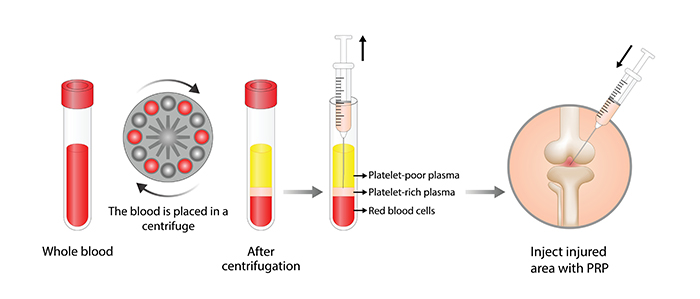Platelet-Rich Plasma (PRP) for Hip Injuries
What is PRP?
PRP (Platelet-Rich Plasma) is a regenerative medicine therapy that involves the use of a patient’s own blood plasma to promote healing and regeneration of tissues. Blood is composed of several components, including red blood cells, white blood cells, plasma, and platelets.
Platelets are small cells in the blood that play a crucial role in the body’s natural healing process by helping to form blood clots to stop bleeding and by releasing growth factors that stimulate the cells that promote tissue repair.

The growth factors and other proteins present in PRP stimulate and accelerate healing by attracting stem cells and other repair cells to the injured site, promoting tissue regeneration, and reducing inflammation. PRP therapy has been used to treat a variety of conditions, including arthritis, tendonitis, ligament sprains, muscle strains, and more.
A small amount of a patient’s blood is drawn and spun in a centrifuge to separate and concentrate the blood platelets. The concentrated platelets and growth factors are combined with the remaining blood and a local anesthetic for your comfort. This concentrated PRP solution is then injected, under ultrasound guidance, into the affected area of the patient’s body, such as a joint or muscle, to promote healing and tissue regeneration.
Side effects are minimal and may include pain at the site of injection that can last for a few hours or days and swelling that resolves within a few days. After treatment a patient will be advised to rest and avoid exercise for a time.
Generally, it can take up to a month to experience pain relief which will improve over the course of 3-6 months after treatment. However, the recovery period is determined by the type and severity of injury.
PRP has been used in the treatment of various hip injuries, including:
- Hip Arthritis: Hip osteoarthritis is a common cause of pain and disability. PRP therapy is safe and effective to reduce pain and inflammation and promote the growth of new cartilage and tissue in the hip joint.
- Hip Labral Tears: The labrum is a ring of cartilage that surrounds the hip socket. Tears in the labrum can be caused by trauma and repetitive motions. Tears cause pain and instability in the hip joint. PRP therapy can help reduce pain and promote healing in patients with labral tears.
- Hip Bursitis: Bursae are small fluid-filled sacs that cushion the hip joint. Inflammation of these sacs can cause hip bursitis, which can be treated with PRP therapy. It is caused by overuse, trauma, spine disease, arthritis, hip surgery and bone spurs. Chronic hip bursitis is painful and difficult to treat. PRP improves pain and function.
- Hip Tendinitis: Tendons connect muscles to bones and can become inflamed and painful, leading to tendinitis. Groin pain from tendinitis of the adductor longus tendon that runs from the pelvis to the thigh bone is common in soccer players, equestrians, football and other sports. PRP therapy is beneficial to reduce inflammation and promote healing in the affected tendons.
- Hip Strains: Strains are injuries to muscles or tendons that occur when they are stretched beyond their limits. PRP therapy can be used to speed up the healing process and reduce pain in patients with hip strains.
- Chronic Hamstring tendinopathy: Chronic hamstring tendon tears are common in athletes. PRP therapy can reduce pain severity and enable quicker return to play.
PRP therapy stimulates and accelerates tissue repair and healing without invasive procedures and the associated risks. PRP therapy may significantly improve your function and quality of life.
There are no safety concerns with PRP therapy, and most people experience a permanent reduction or elimination of pain and inflammation.
It is important to note that PRP therapy is not appropriate for all hip injuries and conditions. It is best to consult with a medical professional to determine if PRP therapy is the right treatment option for your specific hip injury.
When you or a loved one suffers with a hip injury, contact LALL Orthopedics + to schedule a consultation to receive the correct diagnosis and all your treatment options. We have offices in Belvidere, Illinois, Paramus, New Jersey and Philadelphia, PA.
At a Glance
Ajay C. Lall, MD, MS, FAAOS
- Board Certified – Orthopedic Surgery
- Triple Fellowship Trained
- Performs over 750 Surgeries Per Year
- Learn more

